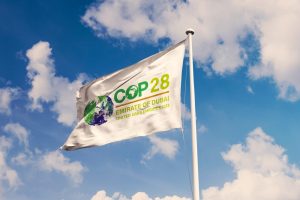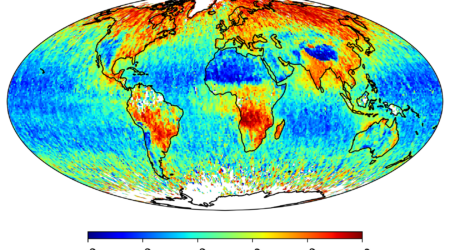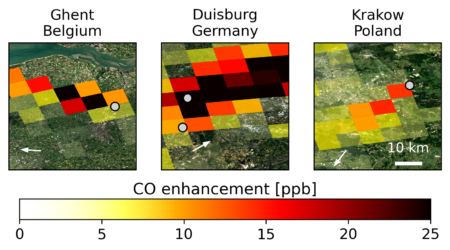COP28: Global projects for landfill methane reduction with satellite monitoring
During COP28 in Dubai, several projects are launched to combat methane emissions from landfills worldwide. SRON Netherlands Institute for Space Research and GHGSat play a key role by scanning the entire globe every day with the Dutch satellite instrument TROPOMI and zooming in with GHGSat satellites.

According to the Intergovernmental Panel on Climate Change (IPCC)’s Sixth Assessment, human-driven methane emissions account for nearly 45% of current net global warming, waste is responsible for a fifth of these methane emissions. Methane remains in the atmosphere for only ten years. Large concentrated methane sources, including some landfills, are therefore prime targets in mitigating climate change. Focused efforts can quickly have a direct effect on global temperatures. On top of that, existing waste dumps often cause air, water, and soil pollution. Progress there can be achieved in harmony with methane reductions. Policymakers, including US special climate envoy John Kerry, are now capitalizing on this opportunity and launching various projects. ‘We see increasing use of satellite data in support of mitigation action, which is really encouraging,’ says Ilse Aben (SRON).
TWOS
Following the pilot with four landfills launched at COP27, now the second phase of the Targeting Waste emissions Observed from Space (TWOS) project starts. ‘In the pilot we demonstrated that not only can we monitor emissions over time, but we’re also able to pinpoint the largest sources within the landfill,’ says Bram Maasakkers (SRON). During the second phase, the parties involved—SRON, GHGSat, and the Global Methane Hub— collaborate with (local) partners and landfill operators to reduce methane emissions from ten waste dumps in the Global South, spread over three continents. From space, TWOS identifies the facilities with the largest mitigation potential. Subsequently, those landfills are monitored once a month for three years to spot and track the largest leaks. The researchers use that information to collaborate with local partners in supporting mitigation efforts.
LOW-Methane
A coalition of international partners launches Lowering Organic Waste Methane (LOW-Methane) at COP28 on December 2. LOW-Methane is a new initiative to accelerate implementation of the Global Methane Pledge Waste Pathway by working with 40 jurisdictions and their national government counterparts to unlock $10 billion to deliver 1 million metric tons of methane reduction from the waste sector by 2030. This work will be supported by a consortium of LOW-Methane partners, including the United States, Bloomberg Philanthropies, SRON and GHGSat. Consortium members will provide support for jurisdiction priorities related to data, technical capacity, policy, and finance. To boost LOW-Methane’s impact on high priority areas, consortium partners also announced plans for cross-cutting work streams on data and finance. Reducing methane goes hand-in-hand with discovering and monitoring leaks, some of which through the TWOS project, including SRON and GHGSat who are also partners in the LOW-Methane initiative.
WasteMAP
The Waste Methane Assessment Platform (WasteMAP), a joint RMI and Clean Air Task Force project, is an open online platform that brings together waste methane emissions data with decisions support tools for decisions makers in the waste sector. The platform is also supported with in-country engagement work, which provides capacity building and technical assistance in advanced monitoring, methane mitigation, capture, and utilization measures to national and subnational stakeholders. Just like the TWOS project, WasteMAP is funded by the NGO Global Methane Hub. SRON supplies satellite emission data on the ten landfills from the TWOS project to WasteMAP. The project will be launched at COP28 on December 1.
UNEP’s MARS
At COP27, the Methane Alert and Response System (MARS) was announced by the United Nations Environment Programme’s International Methane Emissions Observatory (IMEO). The official launch of results from the system’s pilot period will take place on December 1 at COP28. Every three weeks, SRON provides locations of newly discovered large methane hot spots to IMEO that help it refine its search for sources of methane emissions. The MARS project’s initial focus does not only concern emissions from landfills, but firstly emissions from the energy sector—coal mines and in particular from oil and gas installations. Once an emissions source is identified at the facility level, being a UN organization, IMEO then takes on a diplomatic role to start discussions engages with the responsible governments and companies to enable action. ‘UNEP’s IMEO exists to provide open, reliable, and actionable data to those with the power to reduce methane emissions,’ says Manfredi Caltagirone, head of IMEO. ‘MARS is a prime example of how UNEP, with partners like SRON, is providing countries and companies the information needed to deliver climate progress.’

Duo of Satellites Detect Large Methane Emission from Ethiopian Volcano

Dutch space instrument SPEXone produces world map of aerosols

